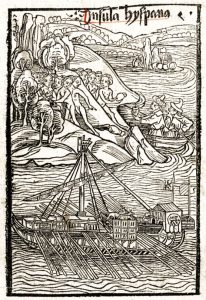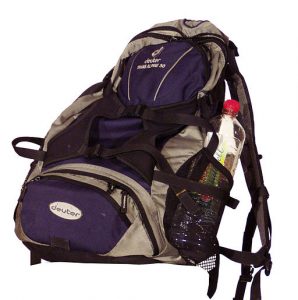Are you traveling for Thanksgiving this week? What kind of suitcase are you taking?
These days, given the madness of airline travel, most of us are doing better at packing light. Even when taking Southwest—bags fly free!—I strive to follow the advice given for a walking trip. Take less than you think you’ll need. Bring only the essentials. Pack your bag and then take half of it out.
What do you pack when it’s a sacred journey rather than an ordinary trip? If any of you have gone on a pilgrimage, I’d love to hear about what you took and what you left behind.
And then there’s spiritual pilgrimage. We often hear it said that life is a sacred journey. What do we take on this kind of trip? What do we pack for our heart’s pilgrimage to Jesus?
We find some advice in packing lists from medieval pilgrimages. Cavalier Santo Brasca, a Milanese, went to the Holy Land in 1480. In his description printed a year later, he told pilgrims exactly what to take on the sea voyage from Venice to Jaffa. Brasca’s list includes an overcoat, a thin mattress, and plenty of food items: white biscuits, loaves of sugar, and good Lombard cheese.
Above all he should have with him a great deal of fruit syrup, because that is what keeps a man alive in the great heat; and also syrup of ginger to settle his stomach if it should be upset by excessive vomiting . . . (Casola, 11-12)
Wow, sounds like pilgrims were in for a delightful trip.
Brasca also says,
Finally, he [the pilgrim] should carry with him two bags — one right full of patience, the other containing two hundred Venetian ducats . . . (Casola, 10)
Here the packing list begins to take on a different character. Brasca introduces a spiritual item: patience.
Pietro Casola, a Milanese Canon who went to Jerusalem in 1494, expanded on this packing list:
Each one who goes on the voyage to the Sepulchre of our Lord has need of three sacks — a sack of patience, a sack of money and a sack of faith. (Casola, 225)

Casola reports with humor how he dipped into one sack or another during the voyage. For example, when half the pilgrims in his group were kept on the galley waiting for permission to disembark in the Holy Land, he said:
[A]s well as possible, we laid hands on one of those sacks we had brought on board the galley — I mean the sack of patience. Many of the pilgrims, seeing how badly we were treated, told the captain that he should not hesitate to lay hands on the other sack if necessary — I mean that of the money — rather than suffer such torments. (Casola, 230)
Later, Casola says that when visiting holy places that are not venerated by the Muslims in charge,
. . . it is necessary to open the third sack, called the sack of faith, otherwise the voyage would be made in vain. (Casola, 247)
A sack of patience, a sack of money, and a sack of faith. So much for packing light! In the Middle Ages, pilgrimage to Jerusalem required the heaviest baggage of all.
So it is on the journey to our interior Jerusalem. When preparing for our journey to Jesus, we pack every spiritual gift we have. All our faith and patience, all the hope and anticipation and perseverance God has given us. It will be almost too much for us to carry. During our pilgrimage, we will dip into our sacks liberally. We will spend everything in them and arrive at our destination depleted. But we shouldn’t worry too much about that. When we kneel at the foot of the cross, Jesus will fill our sacks again.
Did you pack enough patience and faith for your pilgrimage today?
Canon Pietro Casola’s Pilgrimage to Jerusalem In the Year 1494, trans. M. Margaret Newett (Manchester: At the University Press, 1907).
Photo of backpack by Benutzer:Sjr, CC-BY-SA-3.0 (http://creativecommons.org/licenses/by-sa/3.0/), via Wikimedia Commons
